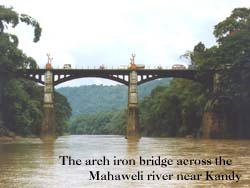 |
 24th May 1998 |
Front Page| |
 Of bridges the British built |
Contents
|
|
 |
Winds of fear draw nearBy Arshad M.HadjirinIn the immediate aftermath of India’s nuclear tests, concern mounted on the likelihood of a nuclear fallout resulting from the five explosions conducted in Rajasthan. Chairman, Atomic Energy Authority of Sri Lanka, Dr.Prinath Dias in an interview with The Sunday Times said “One could never rule out the possibility of a nuclear mishap in India, though it is very unlikely that it could occur.” India, which is just a few kilometres away from Sri Lanka’s northern coasts, has nearly twenty nuclear reactors, of which some strategic plants are located in the southern tip. With their latest nuclear tests, India though asserting that it will not carry out any further tests is now seen as a potential threat in the SAARC region, especially in the eyes of Pakistan. The mounting friction between India and Pakistan could certainly have a bearing on neighbouring Sri Lanka. The nuclear mishap at Chernobyl, Russia, which victimised unaccounted numbers of civilians in Russia and Europe, is a chilling reminder of the havoc wreaked by nuclear calamity. With an arms race raging between India and Pakistan and each trying to sharpen their tools and outrun the other, the region becomes extremely vulnerable. Dr.Dias said that in case of a nuclear leakage in any of the plants in India, radio-active materials or particles may reach Lankan shores in the form of rain clouds or directly through emission. “This is a possibility, depending on which direction the wind blows,” he said referring to northeasterly winds which sweep across the Indian Sub-Continent before bringing rain to Sri Lanka. However he said that countries experimenting with nuclear armaments do adopt stringent safety precautions at their sites. But a confidential document released in India reveals there have been at least 146 nuclear mishaps in India including one major incident at Narora Atomic Power Plant. Radiation emitted from such a disaster could spread over a vast expanse of land and across seas. Dr.Dias reassured that so far the Sri Lankan atmosphere remains uncontaminated. ‘The Sunday Times’ also learns that the AEA had made prompt inquiries from the Meteorological Department to find out wind patterns following the nuclear tests in Rajasthan last week despite the fact that the Rajasthan incident did not precipitate radiation. It is learnt that winds were blowing in a different direction. Professor Summit Ganguly, a specialist on South Asian politics, from Hunter College of the City University of New York, addressing a lecture last week, said that India was drawn into the nuclear weapon scenario because China had developed nuclear weapons and constantly tested them after 1964. India has had a major border dispute with China since 1962. Professor Ganguly said that the nuclear radiation could result in changes to the human genetic structure. “Chances are that children could suffer from various forms of genetic mutations (an arm missing, damaged brain, weak lungs, and missing organs etc.,). Even surviving children and their children live with the probability of genetic mutation. This is perhaps the ugliest feature of nuclear weapons,” he said. He further said that nuclear weapons constituted a revolution in warfare, because they are fundamentally different from other bombs, for three reasons- the enormous heat they generate, the blast, and the radiation. “To a person standing within a certain radius of the detonation of even a small nuclear weapon, it looks at the fireball and it will melt his eyes, like butter. This is due to the sheer amount of heat nuclear weapons could generate,” Professor Ganguly explained. “Similarly the blast could exert an extraordinary amount of pressure per square inch, which would literally crush a human body completely. For instance, so intense was the Hiroshima explosion there were shadows left on the walls,” he said. He said that an instantaneous death is preferable when it came to nuclear radiation. “For people who live, there is nothing worse. There is little or nothing that can be done to save them, and they end up with various forms of cancer, or incurable sores,” he said. AEA’s Dr.Dias said that during the height of the Cold War many people living in both US and the former USSR constructed underground enclosures to protect themselves from radiation. This was mainly due to anxiety about their countries’ build up of weapons. “One shouldn’t expect that to happen, in this region,” he said. In case of a calamity one might be forced to live in seclusion. “Precautions such as evacuation from a contaminated atmosphere, avoidance of food produced from affected areas, going outdoors, etc., are all possible consequences.” Political analysts from diplomatic missions told ‘The Sunday Times’ that it is time, Sri Lanka realised what India’s nuclear capabilities could do to its neighbours. “Being a signatory of the Nuclear non - Proliferation Treaty, Sri Lanka needs to look at India with apprehension,” a foreign embassy spokesperson said. Whether Sri Lanka would take a much closer look at the developments is a question yet to be answered.
More Plus * Starting small
Front Page| News/Comment| Editorial/Opinion| Business| Sports | Mirror Magazine |
|
 |
Please send your comments and suggestions on this web site to |
|